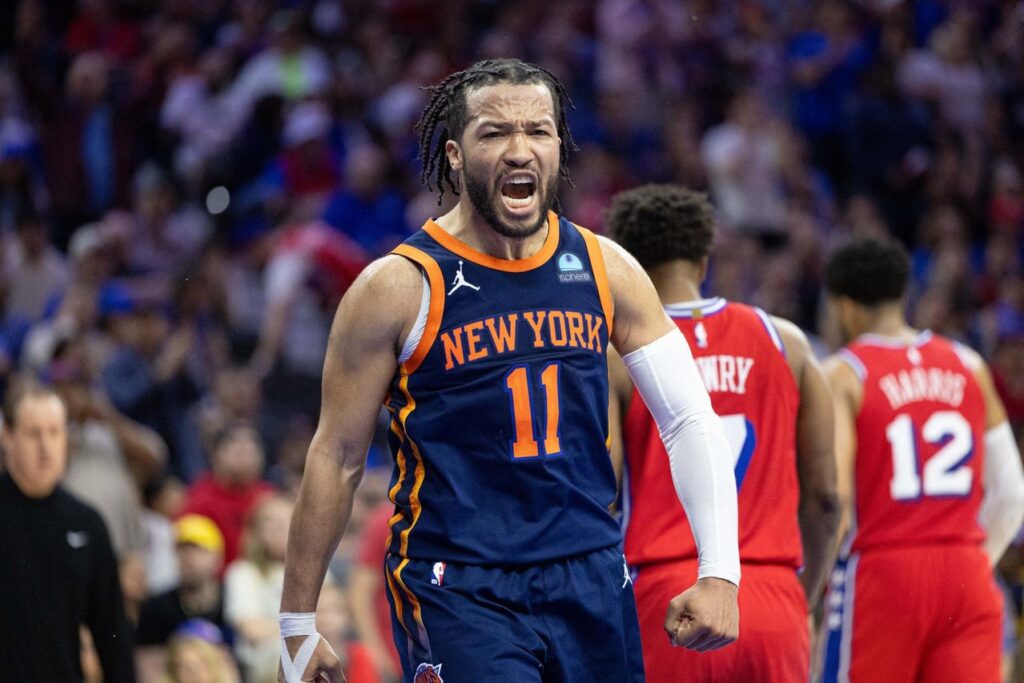
Sixers Take Initiative with Early Offense
From the beginning of the first quarter, the Philadelphia 76ers seized the initiative with their pre-game deployment. Their early offensive setup targeted the size disadvantage of the Knicks’ backcourt, allowing players like Oubre Jr. and Harris to exploit their physical advantages for scoring opportunities. Even without Embiid’s involvement in early offense, Hartenstein had to wait outside the three-point line for Embiid to potentially trail as a trailer. Consequently, with a 4-on-4 situation, the 76ers, with their size advantage, easily found early scoring opportunities through off-ball cuts.
Half-Time Adjustments: Utilizing Embiid’s Positioning
In the half-court offense, the 76ers’ head coach positioned Embiid to receive the ball in deeper positions on the elbows. Despite Embiid’s strong face-up scoring ability, the 76ers cleared out one side, allowing Embiid more comfortable isolation opportunities. This strategy not only leveraged Embiid’s offensive strengths but also exploited DiVincenso’s occasional over-help defense to find cutting opportunities for Oubre. With these two strategies, the 76ers scored 16 points in the painted area in the first quarter, a significant success.
Defensive Challenges: Matchup Issues and Rotations
However, their defense remained average. The 76ers persisted with Oubre guarding Brunson, employing a physical matchup strategy. But when Oubre was substituted for Batum, a slow and less agile defender, I couldn’t understand why they chose to match Batum against Brunson. Although, in hindsight, Brunson and the team failed to capitalize on scoring opportunities towards the end of the first quarter, allowing the lead to widen, I believe this strategy was flawed, as evident in the third quarter.
Knicks’ Offensive Adjustments: Exploiting Defensive Weaknesses
To counter the limitations of wing defenders against Brunson, the Knicks increased the proportion of high Horns Action and Drag Screens, attempting to force switches to exploit Tyrese Maxey’s defense. In the second quarter, when Maxey guarded Brunson, he struggled with Brunson’s backdoor cuts. While Maxey hustled defensively, his size disadvantage remained insurmountable.

Achiuwa’s Impact: Defensive Reinforcement
With Mitchell Robinson and Bojan Bogdanovic sidelined, the Knicks reintroduced Achiuwa as a wildcard in the second quarter, playing him as a small-ball center. Achiuwa’s ability to defend wings and provide rim protection significantly bolstered the Knicks’ defense. His inclusion accelerated the Knicks’ overall defensive rotations and help defense. Achiuwa’s presence as a center ensured every drive was met with triple-team defense, denying the opponent any easy inside opportunities.
Offensive Strategies and Defensive Response
Both teams engaged in back-and-forth offensive and defensive exchanges. The Knicks, aware of Jalen Brunson’s ball-handling threat, attempted to provide more opportunities for shooters like Hart and DDV at the start of the second half. However, their poor shot selection and low offensive intensity, especially from Josh Hart, who had been exceptional in the series, were evident. Despite DDV’s late resurgence with two crucial three-pointers towards the end of the third quarter, it was a timely but insufficient contribution.
Brunson vs. Embiid: A Star Duel
The third quarter saw a showdown between Brunson and Embiid. Brunson’s offensive prowess, especially against Batum, proved to be a mismatch, as he exploited simple screens to create easy scoring opportunities. Embiid’s dominance was evident, drawing five fouls on Hartenstein in a single quarter, consistently scoring to maintain the lead. While Embiid’s ability to draw contact may be unlikable, it’s undeniable, as seen in the officiating leniency compared to others.
Crunch Time: Knicks’ Defensive Excellence
In crucial moments, the Knicks relied on their defensive rotations to secure victory. Particularly, with Hartenstein plagued by foul trouble in the fourth quarter, Coach Thibodeau opted to trust Achiuwa until the end. Despite both teams being physically competitive, the Knicks, facing the size advantage of the 76ers, effectively limited their offense through rotational defense speed. By persisting with OG’s individual defense against Embiid and increasing the speed of double-teams and interior defense, the Knicks successfully contained the 76ers’ offense. In the final moments of the fourth quarter, Achiuwa’s crucial defensive play under the basket sealed the victory for the Knicks.(Casinoplus)
